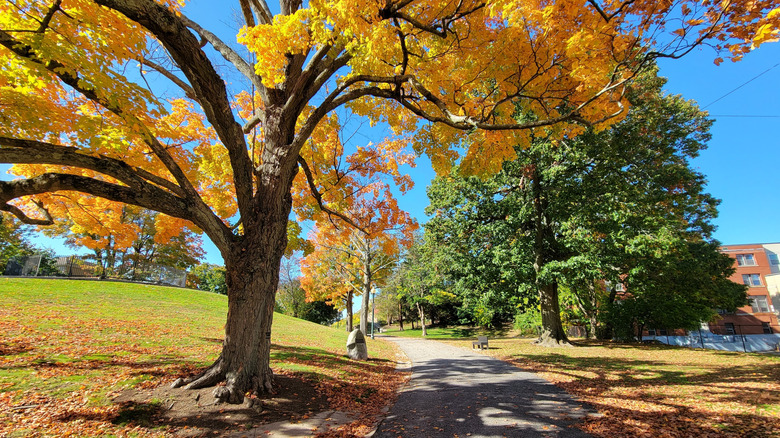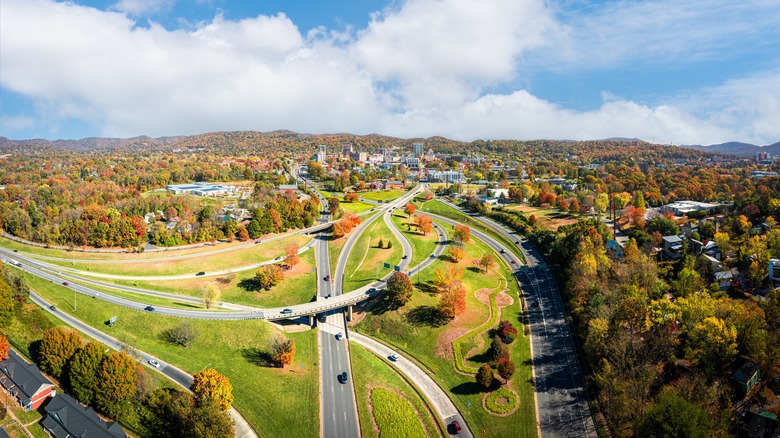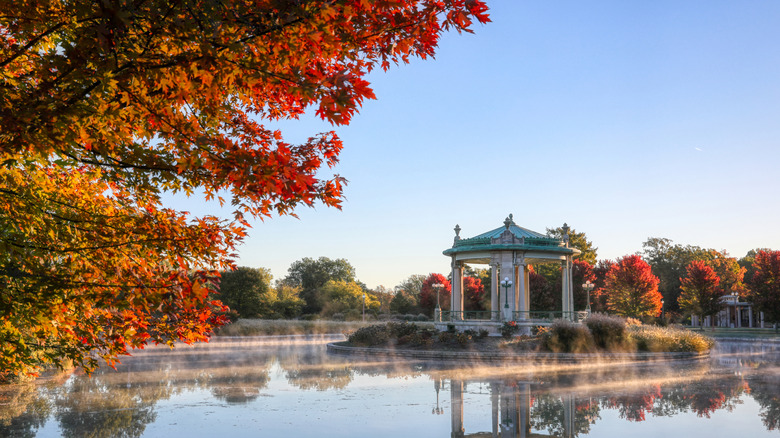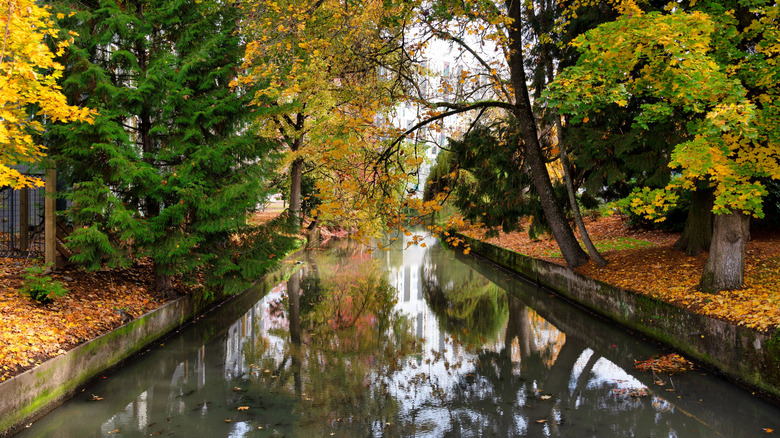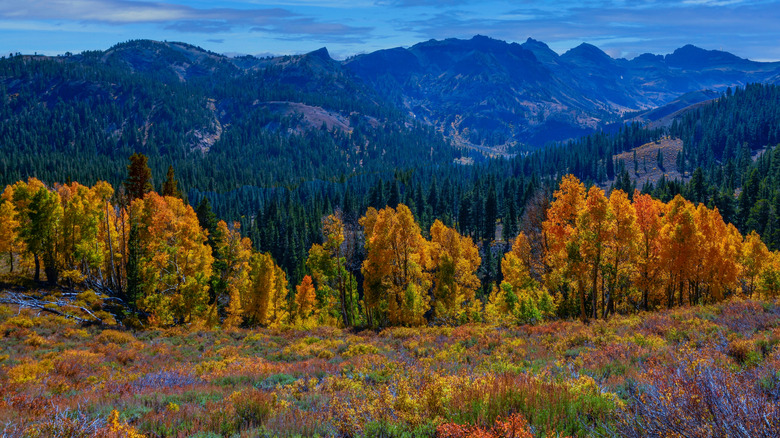U.S. Retirement Destinations For Fall Lovers With Scenic Views And Cozy Temperatures
While it might not be possible to choose the one perfect spot to retire, it'd at least be nice to find a place that covers the basics of what you want. For some folks, this means visions of sunny beaches and tropical waters, like the kind found on the comparatively affordable, pink sand-filled Antigua and Barbuda in the Caribbean. For others, it means upscale golf courses and clubhouses in suburbia, like those found in the fittingly-named Lake Success on Long Island, New York. Others just want some nice fall leaves and weather that doesn't seize the bones with frost. Thankfully, the U.S. and its wide variety of regions and locales are up to the task.
But first, we should mention a couple of caveats. Talk of autumn foliage brings to mind vibrant auburn, vermillion, bright canary yellow, and so forth — the kind you'd see on a town-to-town road trip through Vermont. This kind of foliage is largely limited to certain areas across the U.S., like New England, the Midwest, parts of Appalachia, the Rockies, and the Pacific Northwest. New England might have the upper hand when it comes to brilliant hues, but it's not known for cozy temperatures, especially come winter. The Pacific Northwest is milder, but its colors are more subdued. And both milder temperatures and beautiful scenery speak nothing of retirement concerns like affordability, healthcare, and activities. Each retirement location will have trade-offs.
Nonetheless, we can pass along some solid, suitably autumn choices in this article, complete with reasonably comfortable weather amidst beautiful surroundings. In no certain order, these are Central Falls in Rhode Island, Asheville in North Carolina, St. Louis in Missouri, Eugene in Oregon, and Sonora in California.
Central Falls, Rhode Island, offers retirees a balanced autumn experience
There's nothing quite like a quaint New England town in autumn, complete with crisp air, colonial buildings, and the crinkling of leaves underfoot that managed to escape being raked into giant piles. Tree-coated mountains are absolutely everywhere, especially in a state like Maine, which is covered by 89% forests. But, Maine skews colder than not, with an annual temperature range of 4 to 78 degrees Fahrenheit. To find a sweet spot of autumn scenery meets milder weather in New England, we've got to head a bit south towards coastal Connecticut and Rhode Island. There, we find one of the region's best retirement destinations outside of Providence: Central Falls.
Central Falls hits a sweet spot of moderation on all fronts. It's got New England weather, but that weather is tempered by its location and gets compressed to a range of 22 to 82 degrees Fahrenheit. Greenery peppers the entire town, and congregates in a bunch of small parks like Jenks Park, River Park, and Pierce Park, the latter of which comes with a riverwalk alongside the tree-lined Blackstone River.
Central Falls' terrain is flat, which means that you can't see foliage-covered mountains very easily. But, Central Falls is also located right next to hilly Providence as well as the entirety of Rhode Island, plus neighboring Massachusetts and Connecticut. Massachusetts has 129 combined state parks, state forests, national parks, wildlife refuges, etc., while Connecticut has 142 state parks, all of which are gorgeous in autumn. Central Falls even hosts a nice suite of retiree-focused events around Central Falls every year, like Zumba in the Park, Bohemia Night, Jazz Night Concerts, and more.
Asheville, North Carolina, is a true nature lover's hotspot
For a place not usually associated with autumn foliage, North Carolina is surprisingly pretty come autumn time. North Carolina sits in a sweet spot between coastal beauty, inland hills rolling through the Piedmont, and the Blue Ridge Mountains in the west. It also experiences all four distinct seasons and a full temperature range of 29 to 89 degrees Fahrenheit across the whole state, including a real, colorful, brisk autumn. But out of the whole state, one city keeps coming up again and again as an excellent choice for retirees on the seasonal front and otherwise: Asheville.
Much like Central Falls, Asheville's location tells its story. Asheville sits about 130 miles west of Charlotte, amidst the Blue Ridge Mountains at an elevation of around 2,200 feet. The city is absolutely encased in nature on all sides, including standout locations like the Western North Carolina Nature Center, the Asheville Botanical Garden, Richmond Hill Park, plus a full 71 other parks in the city, and the Blue Ridge Mountains sitting within eyeshot. Every one of these locations — basically everywhere you look in Asheville, on foot or in your car — you're going to find a rich and vibrant autumn when that time of year comes.
In Asheville, you'll also never be overwhelmed with temperatures that veer too hot or cold, as temperatures stay confined to a livable year-round bandwidth of 28 to 83 degrees Fahrenheit. On top of all this, Asheville has a well-known, very lively arts scene that only adds to its value, particularly in its creative hub, the River Arts District.
St. Louis, Missouri, checks all the boxes for affordability and autumn
The Midwest contains quite a wide range of regions, from the summertime soybean fields of Illinois to the snow-coated Upper Peninsula of wintertime Michigan. The whole area experiences a distinct four seasons, including autumn, but tends to get extreme when it comes to temperatures and weather. The Midwest averages 15 to 85 degrees Fahrenheit, but outlier temperatures have reached from -30 to 140. Add to this an average of 56 days of severe weather per year, including tornadoes, and the reader might be wondering where, in such a place, retirees could find a cozy spot to view the autumn leaves. In the end, it's St. Louis, Missouri, that checks all of our boxes.
Looking at temperature, St. Louis typically ranges from 25 to 89 degrees Fahrenheit — yet another example of a retirement spot with a narrower temperature range than its neighbors. The weather can be a little unpredictable on a day-by-day basis, thanks to competing weather systems and air masses, with warm, humid air coming up from the south meeting the cooler continental air mass to the north. But autumn is the most reliable season, weather-wise. It's also the most pleasant and temperate of all seasons, as autumns are both snappy and comfortable.
While you can spot trees practically everywhere across St. Louis, much like Asheville, numerous parks across the city make for excellent leaf-viewing come autumn. Creve Coeur Lake Memorial Park stands out. Located in the city's northwest near the Missouri River, this woodland park surrounds a 320-acre lake of the same name. Locations such as these afford seniors excellent exercise opportunities. Add to this St. Louis' extremely affordable average home value of about $180,000, and you've got a top-tier retirement spot for autumn-loving seniors seeking comfort.
Eugene, Oregon, is a perfectly mild autumn retirement spot
The Pacific Northwest is an ideal place to enjoy autumn, for retirees or anyone else. The U.S. Department of Agriculture's Forest Service oversees 24.9 million acres of forest throughout the entire region, and that says nothing of all the forests in between. But out of the entire, ruggedly beautiful region and year-round dramatic vistas available at places like Olympic National Park, it's Eugene, Oregon, that takes the prize for the best retirement destination to spot seasonal splendor amidst moderate, livable temperatures and weather.
Located about 110 miles south of Portland near Fern Ridge Lake amidst a plethora of parks and abundant trail-walking opportunities, Eugene is a surprisingly mild place. Annual temperatures barely skim the surface of freezing, reaching from 38 to 89 degrees Fahrenheit. Sure, there's a 50% chance of rain for five months out of the year, including autumn, but because temperatures don't freeze, you're safe from snow. Come autumn, you can spot gorgeous foliage and scenery in the countryside or even just down the street.
Because Eugene has such a vibrant social life for seniors, there are also plenty of opportunities for retirees to stay active both indoors and out. Retirement communities, farmers markets, and volunteering communities: All of these connect retirees not only to each other, but to the natural environment. And while Eugene may not be as affordable as the other locations in this article, at an average home price of $471,000, it's still a top choice for autumn-loving elders who want to avoid extreme temperatures and weather.
Sonora, California, is a mountainous, but highly liveable autumnal paradise
For many people, the name California likely brings to mind visions of the Hollywood Hills, beach towns, and palm tree-lined lanes. All of those things are in the Californian south, though, from the greater Los Angeles area through San Diego. Northern California is a totally different, extremely outdoorsy and mountainous, forest-filled beast, one that blends into the Pacific Northwest a bit further north. It's there in NorCal that we find our final retirement spot that combines autumnal vistas with comfortable temperatures. Namely, we mean Sonora (not to be confused with Sonoma).
Located inland from the California coast and about 95 miles southeast of Sacramento, Sonora experiences a very mild, very cozy temperature range that skews marginally hotter than the other locations mentioned, at 41 to 90 degrees Fahrenheit. The weather doesn't get more dramatic than a roughly 30% chance of rain three months out of the year. Sonora is also the smallest retirement destination in our list in terms of population, at around 4,900 people. But, this might suit certain retirees just fine, especially given all the nature surrounding the village.
Aside from being generally surrounded by views of rolling, green-coated hills, Sonora sits directly west of the mammoth, nearly 900,000-acre Stanislaus National Forest and the Sonora Pass beyond it. Stanislaus National Forest is a buffet of 78 lakes, 1,000 miles of trails, and over 800 miles of rivers, while the Sonora Pass is a winding mountain pass that takes drivers directly past peak after peak and connects to the Sierra Nevada Mountain Range. Few could complain about a lack of dramatic autumn scenery amidst such beauty.

